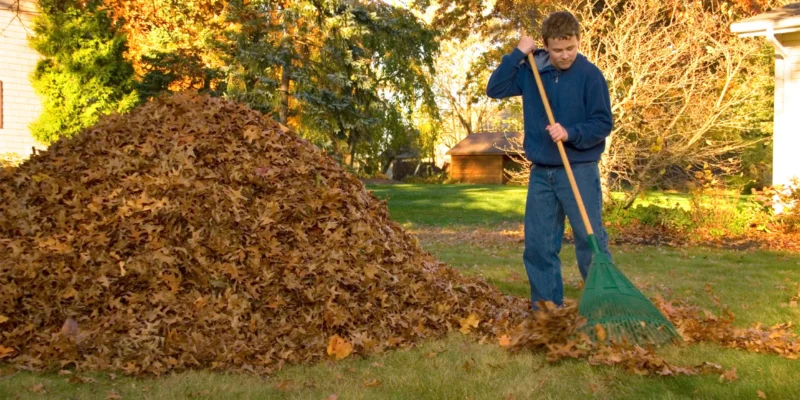As the leaves start to fall and the temperature drops, one might think it’s time to give the lawn a break, but contrary to popular belief, winter is an important phase in the life cycle of your yard.
The care you provide during these cold months can significantly impact your lawn’s performance the following spring and summer.
From fertilizing to mowing practices, this guide will take key steps to ensure your lawn survives and thrives during the harsh winter months.
Why is Winter Lawn Care Important?
For many grasses, winter is a period of dormancy where they stop growing and conserve energy to survive the cold temperatures. But that doesn’t mean your lawn doesn’t need any attention.
Neglecting your lawn during this time can result in weak and unhealthy grass come springtime. In this case, it would take more time to fix it than if you were to take the right steps before the cold weather.
Following proper winter lawn care techniques can promote root growth, prevent diseases, and prepare your yard for a successful growing season.
Fertilizing
Fertilization is crucial for winter lawn care as it provides essential nutrients to the grass and helps it withstand cold temperatures and harsh conditions.
Before the first freeze, apply a slow-release fertilizer to your lawn following the manufacturer’s instructions. This will give your grass the nutrients it needs to stay healthy and strong throughout the winter.
Mowing
As mentioned earlier, many grasses go dormant during the winter, so they don’t require regular mowing. However, keeping your lawn at a manageable length before the first snowfall is essential.
Cutting your grass too short can expose the roots and make them vulnerable to freezing temperatures. On the other hand, leaving it too long can trap moisture and create an ideal environment for disease and pests.
Ideally, you should aim to keep your lawn at a height of around 2-3 inches during the winter months.
Aeration
Aeration is another crucial step in winter lawn care. Over time, soil can become compacted and restrict the flow of water, air, and nutrients to the grassroots.
Aeration involves creating small holes in the lawn to allow for better circulation and penetration of these essential elements. This process also helps to break up thatch build-up, promoting a healthier lawn overall.
Overseeding
Overseeding is spreading grass seed over a lawn to fill in thin or bare areas.
This can be especially beneficial for winter lawn care as it allows new grass to establish itself before the harsh winter conditions set in. Be sure to choose a shade and cold-tolerant grass seed blend suitable for your region.
Clearing Debris
As leaves and branches fall during autumn, it’s essential to clear them from your lawn regularly.
Leaves can smother grass and prevent sunlight from reaching the soil, while debris can create an ideal habitat for pests and diseases. Regularly clearing debris from your lawn will help maintain its health and appearance.
Watering
During the winter, your lawn may not require as much water as it does during the warmer months. However, if there is a prolonged period without precipitation, your lawn can become dehydrated and more susceptible to winter damage.
Make sure to water your lawn deeply once every three weeks or as needed to keep the soil moist but not saturated.
Store Lawn Equipment Properly
Once you’ve completed all the necessary winter lawn care tasks, make sure to store your equipment properly.
Clean and sharpen your lawnmower blades, drain and store hoses, and cover any outdoor furniture or tools to protect them from the elements. You should also empty gas tanks and store them in a safe place.
Properly storing your lawn equipment will prolong its lifespan and save you money on repairs or replacements.
Inspect Trees for Potential Winter Breakage
Before the first snowfall, walk around your yard and inspect any trees or shrubs for potential breakage.
Remove any dead or damaged branches that could threaten your home, lawn, or power lines during winter storms. Trimming any overhanging branches that could accumulate heavy snow and cause damage is also advisable.
You may also want to protect more sensitive trees by wrapping them in burlap or adding a layer of mulch around the base to insulate the roots.
Edge Walkways and Gardens
Lastly, don’t forget to edge your walkways and gardens before the ground freezes.
This will give your lawn a neat appearance and prevent grass from creeping onto paved surfaces and becoming damaged by salt or ice melt products. You can do this with a shovel or an edging tool for a more precise and cleaner look.
If not, you can also contact professionals to find out more about how this is done.
Plan for Spring
Even though winter lawn care is essential, starting planning for spring is also important.
Consider any projects or improvements you would like to make to your yard and research the best timing and techniques for implementation.
Starting early can ensure a healthier and more vibrant lawn next summer. If you put in a little work, you can get a head start when the nice weather kicks in.
Conclusion
Winter lawn care is essential to maintaining a healthy and vibrant yard. By following these key steps, you can ensure your lawn survives and thrives during cold winter.
Remember to fertilize, mow at a proper length, aerate, oversee, water as needed, and store your equipment properly. With these techniques, you can look forward to a beautiful, luscious lawn come springtime.










Comments